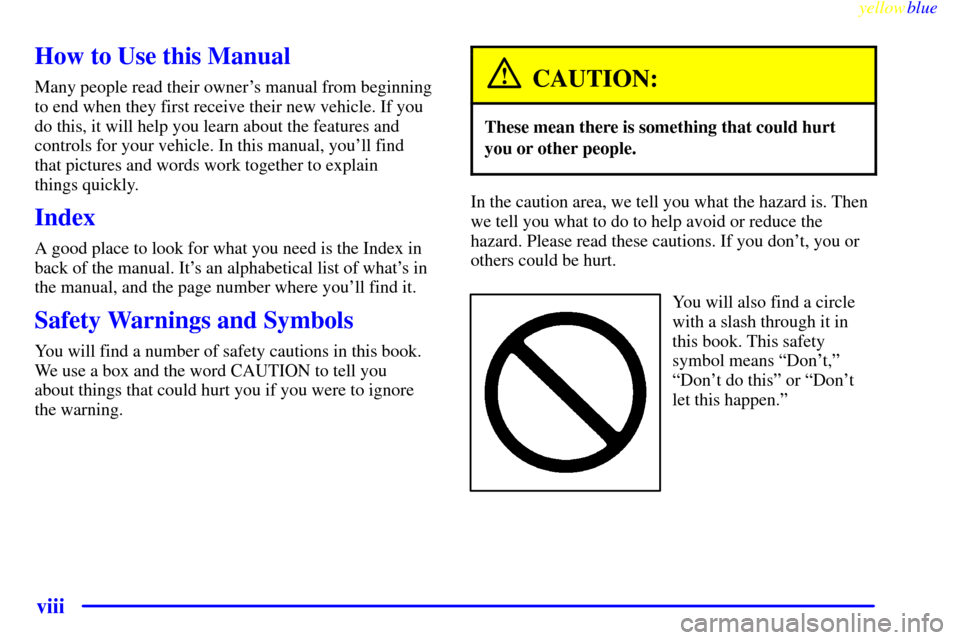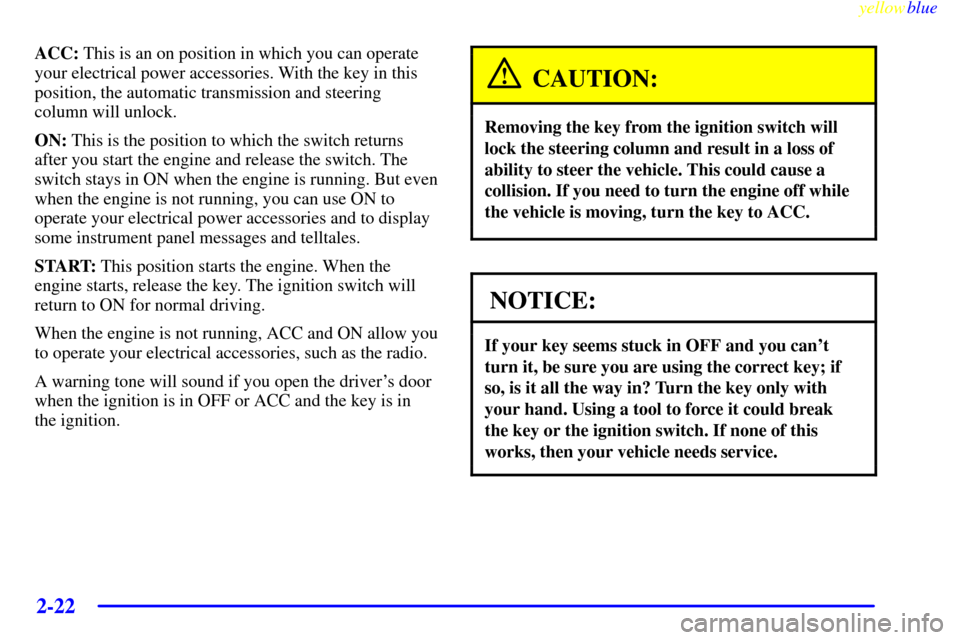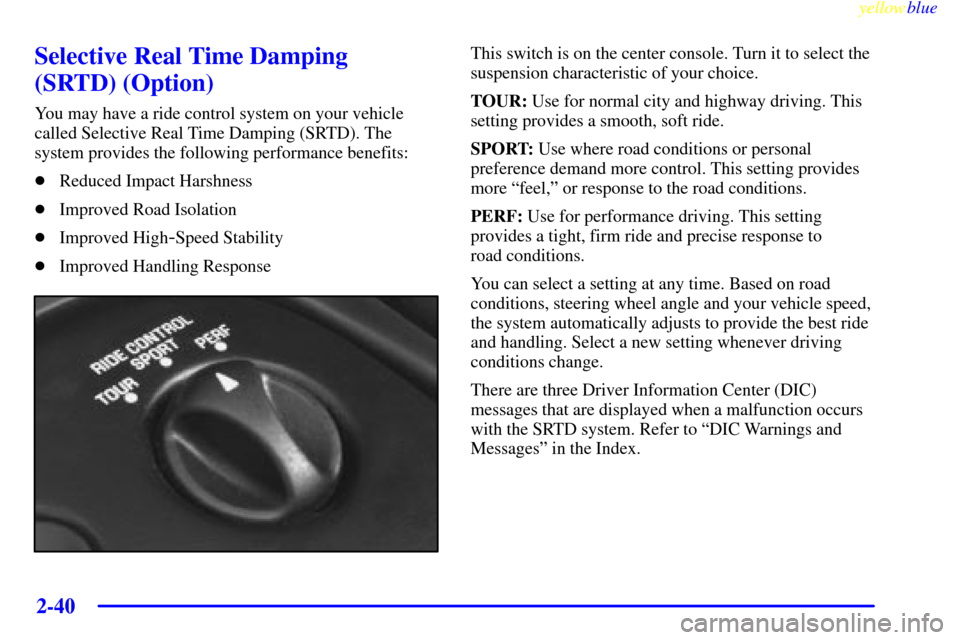Page 8 of 376

yellowblue
viii
How to Use this Manual
Many people read their owner's manual from beginning
to end when they first receive their new vehicle. If you
do this, it will help you learn about the features and
controls for your vehicle. In this manual, you'll find
that pictures and words work together to explain
things quickly.
Index
A good place to look for what you need is the Index in
back of the manual. It's an alphabetical list of what's in
the manual, and the page number where you'll find it.
Safety Warnings and Symbols
You will find a number of safety cautions in this book.
We use a box and the word CAUTION to tell you
about things that could hurt you if you were to ignore
the warning.
CAUTION:
These mean there is something that could hurt
you or other people.
In the caution area, we tell you what the hazard is. Then
we tell you what to do to help avoid or reduce the
hazard. Please read these cautions. If you don't, you or
others could be hurt.
You will also find a circle
with a slash through it in
this book. This safety
symbol means ªDon't,º
ªDon't do thisº or ªDon't
let this happen.º
Page 9 of 376
yellowblue
ix
Vehicle Damage Warnings
Also, in this book you will find these notices:
NOTICE:
These mean there is something that could
damage your vehicle.
In the notice area, we tell you about something that
can damage your vehicle. Many times, this damage
would not be covered by your warranty, and it could
be costly. But the notice will tell you what to do to help
avoid the damage.
When you read other manuals, you might see
CAUTION and NOTICE warnings in different colors
or in different words.
You'll also see warning labels on your vehicle. They use
the same words, CAUTION or NOTICE.
Page 10 of 376
yellowblue
x
For example,
these symbols
are used on an
original battery:
CAUTION
POSSIBLE
INJURY
PROTECT
EYES BY
SHIELDING
CAUSTIC
BATTERY
ACID COULD
CAUSE
BURNS
AVOID
SPARKS OR
FLAMES
SPARK OR
FLAME
COULD
EXPLODE
BATTERY
These symbols
are important
for you and
your passengers
whenever your
vehicle is
driven:
DOOR LOCK
UNLOCK
FASTEN
SEAT
BELTS
POWER
WINDOW
AIR BAG
These symbols
have to do with
your lamps:
MASTER
LIGHTING
SWITCH
TURN
SIGNALS
PARKING
LAMPS
HAZARD
WARNING
FLASHER
DAYTIME
RUNNING
LAMPS
FOG LAMPS
These symbols
are on some of
your controls:
WINDSHIELD
WIPER
WINDSHIELD
WASHER
WINDSHIELD
DEFROSTER
REAR
WINDOW
DEFOGGER
VENTILATING
FAN
These symbols
are used on
warning and
indicator lights:
ENGINE
COOLANT
TEMP
BATTERY
CHARGING
SYSTEM
BRAKE
COOLANT
ENGINE OIL
PRESSURE
ANTI-LOCK
BRAKES
Here are some
other symbols
you may see:
FUSE
LIGHTER
HORN
SPEAKER
FUEL
Vehicle Symbols
These are some of the symbols you may find on your vehicle.
Page 53 of 376

2-
yellowblue
2-1
Section 2 Features and Controls
Here you can learn about the many standard and optional features on your vehicle, and information on starting,
shifting and braking. Also explained are the instrument panel and the warning systems that tell you if everything is
working properly
-- and what to do if you have a problem.
2
-4 Door Locks
2
-6 Memory (Option)
2
-7 Remote Function Actuation System
2
-14 Remote Hatch/Trunk Lid Release
2
-17 Universal Theft-Deterrent (Option)
2
-19 PASS-Key�
2-20 New Vehicle ªBreak-Inº
2
-21 Ignition Positions
2
-23 Starting Your Engine
2
-25 Engine Coolant Heater (If Equipped)
2
-27 Automatic Transmission Operation
2
-30 Manual Transmission Operation
2
-34 Parking Brake
2
-35 Shifting Into PARK (P)
(Automatic Transmission Only)
2
-37 Shifting Out of PARK (P)
(Automatic Transmission)
2
-37 Parking Your Vehicle (Manual Transmission)2
-38 Parking Over Things That Burn
2
-38 Engine Exhaust
2
-39 Running Your Engine While You're Parked
(Automatic Transmission)
2
-39 Limited-Slip Rear Axle
2
-40 Selective Real Time Damping (SRTD) (Option)
2
-41 Windows
2
-43 Turn Signal/Multifunction Lever
2
-51 Exterior Lamps
2
-53 Interior Lamps
2
-54 Mirrors
2
-56 Storage Compartments
2
-61 Roof Panel (Option)
2
-68 Convertible Top (Option)
2
-74 The Instrument Panel -- Your
Information System
2
-77 Warning Lights, Gages and Messages
2
-92 Driver Information Center (DIC)
Page 64 of 376

yellowblue
2-12
To match transmitters to your vehicle:
1. Turn the ignition key to ON.
2. Clear any warning messages on the Driver
Information Center (DIC) by pressing the
RESET button.
3. Press the OPTIONS button on the DIC several times
until the blank page is displayed, then press and hold
the RESET button for two seconds.
4. When the message FOB TRAINING is displayed,
push the RESET button once. The message
HOLD LK + UNLK 1ST FOB in the DIC will
be displayed.
5. Press and hold the LOCK and UNLOCK buttons on
the transmitter simultaneously for 15 seconds.
6. When a transmitter is learned (matched), the DIC
will display FOB LEARNED and then prompt you
to learn the next transmitter.
7. Repeat Steps 5 and 6 for each additional transmitter.
8. Remove the key from the ignition.The programming mode will shut off if:
�You don't program any transmitters for two minutes.
�You take the key out of the ignition.
�You have programmed three transmitters.
Battery Replacement
Under normal use, the battery in your key fob
transmitter should last about 18 months.
You can tell the battery is weak if the transmitter won't
work at the normal range in any location. If you have to
get close to your vehicle before the transmitter works,
it's probably time to change the battery.
NOTICE:
When replacing the battery, use care not to
touch any of the circuitry. Static from your
body transferred to these surfaces may damage
the transmitter.
Page 74 of 376

yellowblue
2-22
ACC: This is an on position in which you can operate
your electrical power accessories. With the key in this
position, the automatic transmission and steering
column will unlock.
ON: This is the position to which the switch returns
after you start the engine and release the switch. The
switch stays in ON when the engine is running. But even
when the engine is not running, you can use ON to
operate your electrical power accessories and to display
some instrument panel messages and telltales.
START: This position starts the engine. When the
engine starts, release the key. The ignition switch will
return to ON for normal driving.
When the engine is not running, ACC and ON allow you
to operate your electrical accessories, such as the radio.
A warning tone will sound if you open the driver's door
when the ignition is in OFF or ACC and the key is in
the ignition.
CAUTION:
Removing the key from the ignition switch will
lock the steering column and result in a loss of
ability to steer the vehicle. This could cause a
collision. If you need to turn the engine off while
the vehicle is moving, turn the key to ACC.
NOTICE:
If your key seems stuck in OFF and you can't
turn it, be sure you are using the correct key; if
so, is it all the way in? Turn the key only with
your hand. Using a tool to force it could break
the key or the ignition switch. If none of this
works, then your vehicle needs service.
Page 86 of 376
yellowblue
2-34
Parking Brake
To set the parking brake, hold the brake pedal down.
Pull the parking brake lever. This sets your parking
brake. If the ignition is on, the brake system warning
light will come on.
To release the parking brake, hold the brake pedal down.
Hold the release button in as you move the parking
brake lever all the way down.
NOTICE:
Driving with the parking brake on can cause
your rear brakes to overheat. You may have to
replace them, and you could also damage other
parts of your vehicle. Make sure the brake
warning light is not on before driving.
Page 92 of 376

yellowblue
2-40
Selective Real Time Damping
(SRTD) (Option)
You may have a ride control system on your vehicle
called Selective Real Time Damping (SRTD). The
system provides the following performance benefits:
�Reduced Impact Harshness
�Improved Road Isolation
�Improved High
-Speed Stability
�Improved Handling Response
This switch is on the center console. Turn it to select the
suspension characteristic of your choice.
TOUR: Use for normal city and highway driving. This
setting provides a smooth, soft ride.
SPORT: Use where road conditions or personal
preference demand more control. This setting provides
more ªfeel,º or response to the road conditions.
PERF: Use for performance driving. This setting
provides a tight, firm ride and precise response to
road conditions.
You can select a setting at any time. Based on road
conditions, steering wheel angle and your vehicle speed,
the system automatically adjusts to provide the best ride
and handling. Select a new setting whenever driving
conditions change.
There are three Driver Information Center (DIC)
messages that are displayed when a malfunction occurs
with the SRTD system. Refer to ªDIC Warnings and
Messagesº in the Index.